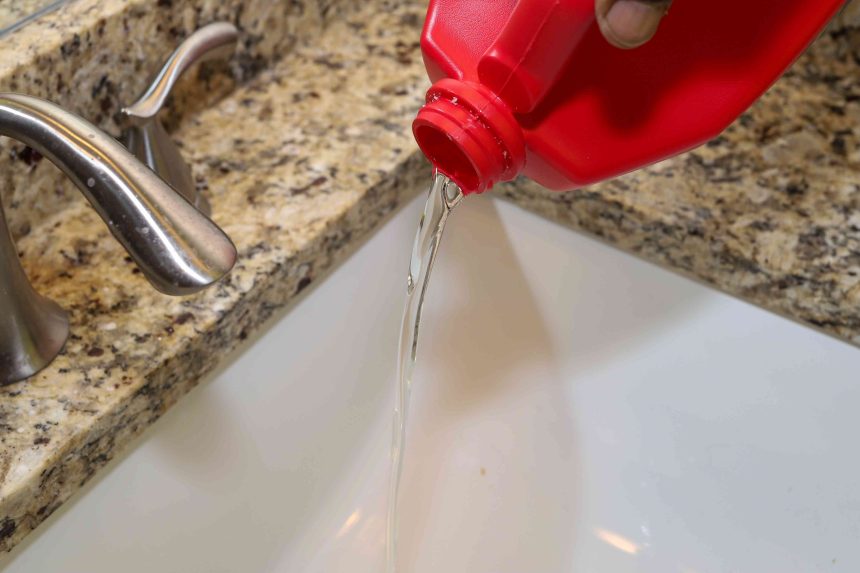A home’s plumbing system is essential for directing clean water to every faucet, shower, tub, and water-using appliance in the house, while also providing a safe, easy way to drain waste and wastewater from sinks, toilets, and other drains. However, these drainage lines can develop full or partial clogs that prevent the wastewater from flowing freely.
When this occurs, many homeowners turn to chemical cleaners, like Drano, to quickly break down the organic materials clogging the drain. When this method of clearing the drain is used frequently though, the chemical composition of Drano can cause damage to the existing plumbing system, especially for pipes and fixtures older than 20 years. Check out this guide to discover if you should use Drano, when to use it, and when an alternative solution would be best.
What Is Drano?
Drano is a popular drain cleaner containing lye, aluminum, salt, bleach, and sodium nitrate to create a chemical reaction that will quickly and effectively break down organic material, like hair and grease. The lye decomposes the organic material and works with the aluminum to generate heat that helps to speed up the decomposition process. Adding warm water to the solution can increase the reaction, leading to even more heat and faster decomposition.
The lye then reacts with the softened grease in the drains to create a soapy solution that reacts with the aluminum. This generates hydrogen bubbles that help to loosen the clog and carry the particles down the drain. However, the heat and chemical reactions created by Drano don’t just affect the clog, they also affect the drainage system.
Is Drano Safe to Use on Plumbing?
Due to the chemical composition and reactions created by Drano, it should be used sparingly to avoid damaging the plumbing system. The heat generated by the chemical reactions can damage plastic pipes, break down the glue holding the pipes together, and cause delicate plumbing fixtures, like porcelain toilets, to crack.
Additionally, if Drano is used frequently, it can remain in the drain, slowly eating away at the pipes. It can also react with other chemical cleaners, creating harmful fumes that might escape through the other drains in the home. Inhaling these fumes can cause serious damage to your lungs, which is why it’s necessary to thoroughly flush the drains after using any type of chemical cleaner. Also, it’s important to avoid coming into direct contact with the Drano solution, as its caustic nature can lead to skin irritation and chemical burns.
Safer Methods for Drain and Pipe Cleaning
There are a wide variety of tools and solutions that can be used to clear clogs and clean the drain lines in your home. Before resorting to Drano to break up clogs and restore the free flow of wastewater through your drain, try one of these safer cleaning methods first.
- Use a plunger to unclog toilets and sinks. Just make sure to use the right type of plunger for the drain.
- Drain snakes are long, slender tools designed to slide into the drain where they can grab or break up clogs. Use these plumbing tools when the clogs are close to the drain and along a relatively simple drain line.
- Enzymatic drain cleaners use natural bacteria and enzymes to eat away at organic waste, allowing them to break up clogs without harming the plumbing. These drain cleaners are not as heavy-duty as Drano but are suitable for slow-running drains and light clogs.
- Drain augers are similar to drain snakes, except they tend to be longer, thicker, and might be motorized to increase the physical cleaning power. Plumbers often use drain augers when they are called to deal with a clogged drain line.
When to Use Drano
Drano can be a very effective solution for getting rid of clogs, but it should not be used regularly. Turn to Drano to deal with minor clogs where some food, hair, or grease is stuck in the drain line, or to get rid of more heavy-duty organic clogs. Additionally, Drano can be a great option for cleaning the shower drain where soap buildup and hair clumps can create blockages.
When you deal with extensive plumbing networks or complex drainage systems, it might be difficult to reach the location of the clog with a drain snake or drain auger, which is when you could use Drano. Be sure not to use Drano too often and thoroughly flush the pipes with hot water after clearing the clog to rinse away any residual Drano solution.
When to Avoid Drano
In most cases, Drano should not be your first option to clear the drain, as its chemical reaction can cause damage to the pipes, glue, and plumbing fixtures. Drano can be especially damaging to more delicate materials, like porcelain, which might not be able to withstand the heat generated by the chemical reaction, resulting in cracking.
If you experience repeated clogs in the same area of the home, persistent clogs that Drano doesn’t seem to clear, and clogs caused by nonorganic materials, then you should avoid using Drano. Instead, try using a plunger, drain snake, or drain auger to physically break up or remove the clog from the drain line.
When to Call a Professional
Not all plumbing problems can be resolved with quick and easy DIY methods, so if Drano doesn’t work and you’re unable to clear the clog using any alternatives available, then it’s time to call a professional plumber to address the situation.
Professional plumbers will know how to assess and tackle the problem without damaging the plumbing system. Inform them if you have recently used Drano or any other chemical drain cleaners so that they can take proper safety precautions when working with your plumbing.







